Common Causes of Servo Motor Failures and Preventative Measures to Limit Downtime
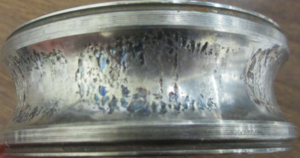
Bearing Failure
Description: Bearing failure can be caused by many variables. If bearing failure is not detected early, the bearing will continue to break down and cause other components to fail – leading to catastrophic failure.
Example: A customer’s servo motor was repaired in another repair shop and the housing was reinstalled without checking the runout and perpendicularity to the flange. This resulted in the motor being reinstalled with the bearings misaligned.
Solution: Many factors can cause premature bearing failure. Regular vibration analysis can be used to trend bearing condition and prevent catastrophic failure.
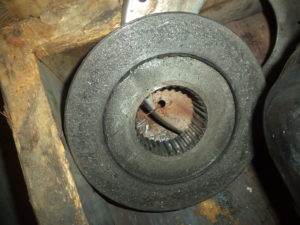
Brake Failure
Description: Just like your car, brake pads in your servo motor are prone to wear. Environmental conditions and the number of stops at different levels of torque will also determine wear.
Example: A brake hub on a motor wore out causing brake dust to get into the windings.
Solution: Keep track of how long a brake has been in service and when possible see how much wear is on the brake pads to forecast brake pad replacement.
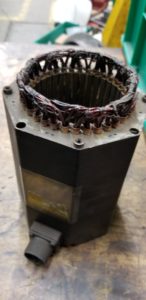
Winding Failure
Description: Windings can fail from a wide variety of causes including some of the topics discussed in this blog. Other examples include failure from power faults, poor insulation systems, improper repair, poor manufacturer quality, age, etc.
Example: A repair shop did not wind the motor with precise machine wound coils. The coils came out of the end of the lamination slot at an angle and abraded the winding to the steel corner of the lamination causing a short to ground. Coils need to come out straight from the lamination slot and then bend.
Solution: Ensure your motors are protected from conditions that can cause winding failures while confirming that the motor is rated for the correct application. If your motor is in need of a new winding, make sure your motors are precision wound per factory specifications or better. Accurate rewinding results in correct amperage, impedance, resistance and longer life for the rewind.
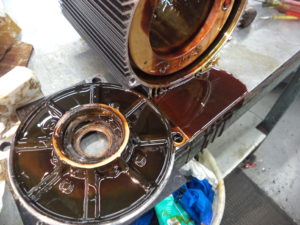
Contamination
Description: Contamination can cause failures on any component of your servo motor, ie. winding failure, bearing failure, encoder failure, etc.
Example: A robotic arm gearbox is overfilled with oil causing high pressures. The high pressure causes oil to leak through the seal and enters the motor.
Solution: Ensure attached gearboxes are not overfilled and protect the motors from being sprayed with contaminants when possible. If your motor is in an extreme environment, consider Ultra Sealing your motor windings to prevent contamination. Read about it here: How to Extend the Life of Your Servo and Spindle Motors in Extreme Environments.
For more information on how contamination can impact all types of motors, read our blog “Electric Motors and Generators Fail from Contamination.”
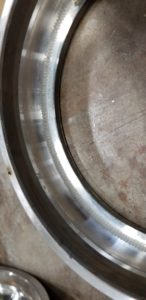
Electrical Noise from Variable Frequency Drive System
Description: The fast switching transistors inside frequency drives can cause common mode currents that damage windings, bearings, or make electrical noise that interferes with system electronics.
Example: A motor was not properly grounded and it caused the frequency drive to output heavy noise into the electronic system.
Solution: Ensure the motors are rated for the frequency drive, that all systems are properly grounded, and/or install CoolBLUE inductive absorbers to reduce common mode currents.
For more information on how Variable Frequency Drives work, visit Basics of Variable Frequency Drives. Also visit Coolblue Inductive Absorbers and Aegis Shaft Grounding Rings to learn how these products protect your motor bearings from damaging currents.
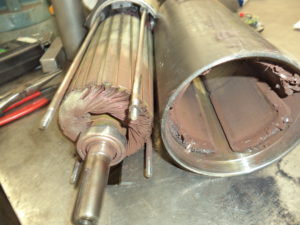
Demagnetization of Permanent Magnets
Description: If a servo motor is overloaded, it will demagnetize the permanent magnets. When the magnets lose strength, the servo motor will not be able to handle the loads it is designed for.
Example: A robotic arm was programmed to pick up a load that places a high starting current on the motor, resulting in the motor overloading.
Solution: Make sure the servo motors are designed to handle the loads you require. Also be cognizant of high starting and stopping currents that can overload the motor.
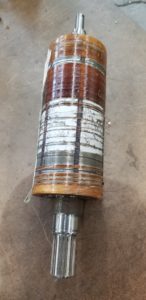
Rotor Banding Failure
Description: Some servo motors with permanent magnet rotors have banding to hold the magnets in place. Mechanical wear, overload conditions, or age can cause the banding to come undone. This allows for the magnets to fly outward and catastrophically damage the insides of the motor.
Example: A servo motor gets subject to extreme heat causing the banding to fall apart. The magnets fly out and destroyed the motor winding.
Solution: When selecting a servo motor for an application, keep in mind that the motor should be able to handle the environment.

Electrostatic Discharge (ESD)
Description: ESD is the flow of electricity via contact between two charged objects. ESD can shock electronic components and delete programs/memory on systems.
Example: An encoder plug was disconnected without properly being shut down. The remaining static charge shocked the encoder, deleting its memory when the plug was disconnected.
Solution: Ensure that all electronic components are handled while grounding it by hand, and any static charges are discharged.

Age and Fatigue of Electronic Components
Description: Electronic components age faster than the other components in servo motors. Depending on environmental conditions, encoders, resolvers, or tachometers may only last a certain amount of time.
Example: A motor has been in service for 5 years and now the encoder no longer outputs signal.
Solution: Keep track of how long encoders have been in service and know when to have it replaced with new.

Leave a Reply
Want to join the discussion?Feel free to contribute!